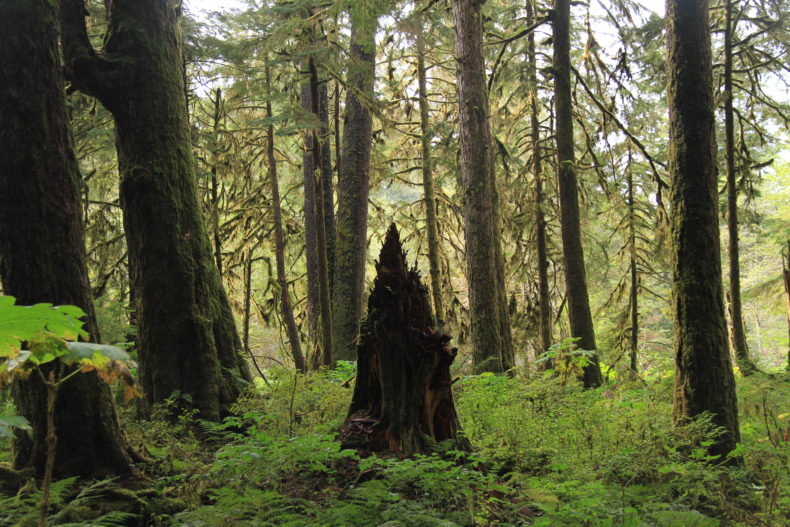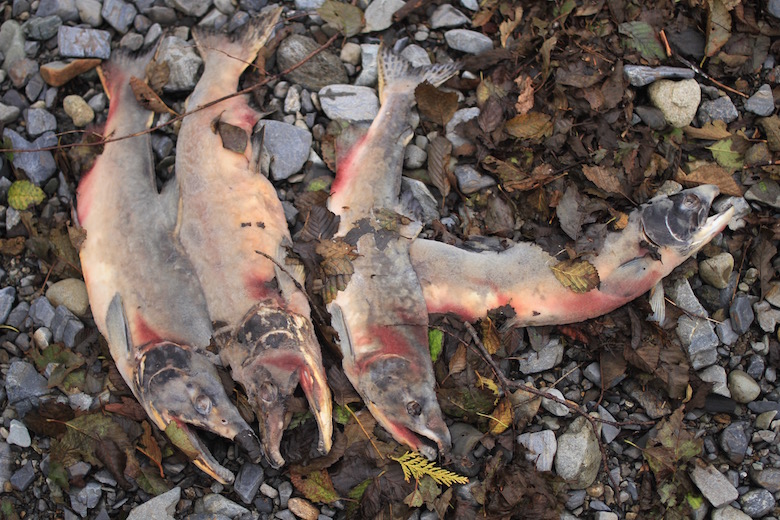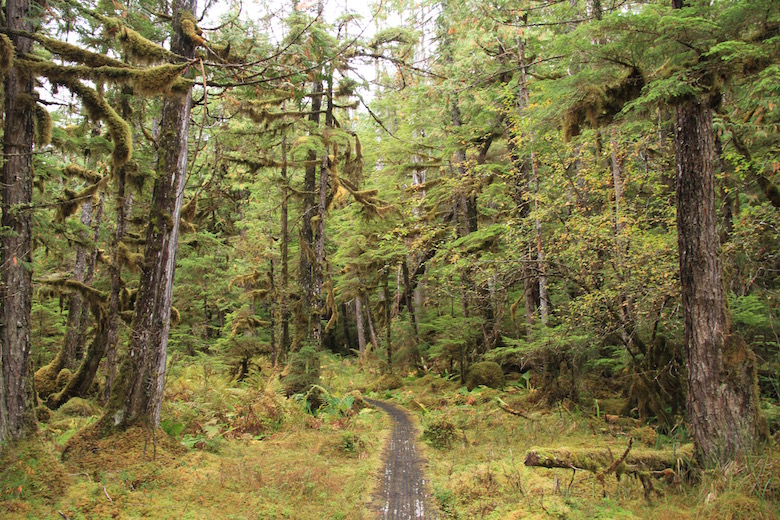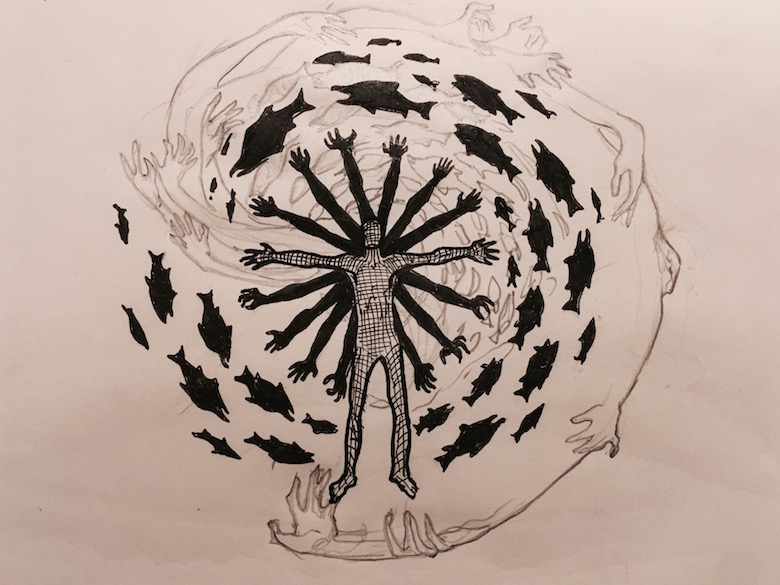
There are several things you’re likely to notice if you fly over Southeast Alaska’s Alexander Archipelago on a clear day. If you’re an alpine junky like me, the first will be the snowcapped mountains that stretch seemingly without end from near the coast to the eastern horizon somewhere in Canada, their white-and-gray-tongued glaciers pouring all the way to the sea. The second is the serene sea itself, scattered with more than 1,000 islands that jut down from the state along the coast like a shattered thumb. The third thing, the thing that Southeast Alaska and British Columbia have in greater abundance than just about everywhere else on Earth, is drippy, sponge-floored old-growth temperate rainforest.
It furs the near-coast foothills, the lower toes of peaks and all those islands for miles—dark, silvered at the edges with hanging lichens and mosses, youthful with saplings, wise with centuries-old giants, boney with standing snags. It looks like the hide of something Maurice Sendak would have drawn, or of one of Jim Henson’s fantastical creatures, or of something you can’t quite imagine at all. It looks wild in the truest sense of the word.
The last time I saw it was September, when I visited Southeast Alaska to do some reporting on the Tongass National Forest, which contains much of Alaska’s portion of that temperate rainforest. The Tongass’s 16.7 million acres – an area the size of West Virginia, and encompassing 80 percent of Southeast’s landmass—is a mix of rock, ice, and bog, and more than 9 million acres of trees. It is home to one of the world’s most productive salmon fisheries. And compared to other exceptionally fecund ecoregions, it is still largely intact — 85 percent compared to, say, my adopted home in western Oregon, at about 8 percent, as Juneau-based naturalist Richard Carstensen pointed out to me when we spoke by phone.

It is, in other words, an unusually abundant place. It’s also the last national forest in the U.S. where old-growth trees are still clearcut on an industrial scale. The archipelago’s ragged, wild hide is patchy with new and old clearcuts on national forest land, as well as on neighboring state and tribal lands.
It’s here that the Tongass’s story gets really interesting, and difficult to untangle. In the Lower 48, it’s practically conventional wisdom by now that cutting down big swaths of old-growth forest is wrong. That’s in large part because there’s so little left down here that the last scraps are easy for most folks to understand as precious – as refuge habitat for common and endangered wildlife alike, as source of subsistence and sanctuary for all kinds of people.
But in the Tongass—even after decades of intense clearcutting starting in the 1940s and ’50s—just 12 percent of the productive old-growth rainforest has been logged. Some Alaska millers and loggers and many of their supporters point to the abundant remaining forest as evidence that the practice can and should continue indefinitely, and on a much broader scale than currently allowed (nevermind that the economics don’t support this). They also point out, correctly, that the forest has no threatened or endangered species—yet. Its salmon runs are, overall, quite healthy. Its wildlife populations, with the exception of localized impacts to species like deer and wolves, largely still robust. And tourism to the region has surged even as logging has continued.
It wasn’t hard for me to see why: The sheer amount of forest, logged or no, is overwhelming. The land feels big. Like BIG big. I saw five black bears in two days just on the few paved roads, without trying; scads of Sitka blacktailed deer hung around on the shoulders; salmon carcasses littered streamsides and filled the air with their stink in a way I had never experienced in the Pacific Northwest.

As such, the conservationists who stump (ahem) for protecting the remaining old growth forest in the Tongass must rely on incredibly nuanced arguments that don’t distill easily into soundbytes. Yes, there’s lots left, they acknowledge, but the best stuff is mostly gone. According to one widely cited 2013 study, the 12 percent that has been cut to date was concentrated largely in the region’s most productive stands of very large trees – with those larger than 3-feet in diameter, rare to begin with, practically extirpated, and contiguous forests of big old trees reduced by two thirds to nearly 95 percent, depending on where you look.
Even so, David Albert of The Nature Conservancy, one of the authors of that 2013 study, told me, “It’s hard to make the case to local people that we’ve ruined the Tongass. It’s still productive and diverse.”

And it made me realize—driving a rented SUV around Prince of Wales Island, where some of the most intensive logging is concentrated—that most of the ways people argue for conservation, and most of the tools people use to accomplish it, depend on the idea of scarcity, of rarity. The U.S. Endangered Species Act is designed to keep creatures from blinking out, but it doesn’t really motivate habitat protection all that well until they’re already vastly reduced in number. Even then, its success is mixed at best. Other environmental laws, too, fall into this mold: Where air is clean, for example, the Clean Air Act generally permits more pollution than in places where clean air is scarce.
Pausing at a pullout to photograph a freshly shorn swath of stumps, I couldn’t help but wonder: Can we come up with an effective language in the modern era – let alone the political will and legal mechanisms – to motivate the protection of natural abundance as a value in and of itself? Because what is more worth protecting than a system that does not need us to tinker with it? That not just sustains biodiversity, but supplies our wild food, our clean water, our clean air, even carbon storage the buffers the worst of our fossil fuel profligacy, without human nudging or out-and-out wrangling?

The trouble with abundance is that, when you’re surrounded by it, it’s easy to forget that it, too, can vanish. Not just through wholesale, dramatic destruction, but through barely noticeable chiseling away over decades or centuries. So it is that the main argument for protecting the Tongass’ largely unspoiled riches – its prolific salmon, its unroaded expanses, its thick and thrashy forest with grizzlies and wolves and eagles – still comes down to scarcity. In a world so thoroughly denuded and changed by human activities, true abundance is now an incredibly rare thing.
On the plane from Portland to Seattle, I had pressed close to my window for a better view of the rolling hills of western Washington. What unfurled below me seemed less forest than forest-that-was, densely-packed with clearcuts, populated with absence, its wild hide scraped mostly away to make way for something tamer, something impoverished. When I glanced up, I noticed the woman in the seat ahead of me was looking intently over the same landscape, her forehead pressed against the glass. A flicker fell in the lit space between the window and her face. It took me a beat to realize that it was a tear, then another.

Original photographs and artwork by the author